Phillip Isola
MIT
Results of the NeurIPS 2023 Neural MMO Competition on Multi-task Reinforcement Learning
Aug 17, 2025Abstract:We present the results of the NeurIPS 2023 Neural MMO Competition, which attracted over 200 participants and submissions. Participants trained goal-conditional policies that generalize to tasks, maps, and opponents never seen during training. The top solution achieved a score 4x higher than our baseline within 8 hours of training on a single 4090 GPU. We open-source everything relating to Neural MMO and the competition under the MIT license, including the policy weights and training code for our baseline and for the top submissions.
Training Transformers with Enforced Lipschitz Constants
Jul 17, 2025Abstract:Neural networks are often highly sensitive to input and weight perturbations. This sensitivity has been linked to pathologies such as vulnerability to adversarial examples, divergent training, and overfitting. To combat these problems, past research has looked at building neural networks entirely from Lipschitz components. However, these techniques have not matured to the point where researchers have trained a modern architecture such as a transformer with a Lipschitz certificate enforced beyond initialization. To explore this gap, we begin by developing and benchmarking novel, computationally-efficient tools for maintaining norm-constrained weight matrices. Applying these tools, we are able to train transformer models with Lipschitz bounds enforced throughout training. We find that optimizer dynamics matter: switching from AdamW to Muon improves standard methods -- weight decay and spectral normalization -- allowing models to reach equal performance with a lower Lipschitz bound. Inspired by Muon's update having a fixed spectral norm, we co-design a weight constraint method that improves the Lipschitz vs. performance tradeoff on MLPs and 2M parameter transformers. Our 2-Lipschitz transformer on Shakespeare text reaches validation accuracy 60%. Scaling to 145M parameters, our 10-Lipschitz transformer reaches 21% accuracy on internet text. However, to match the NanoGPT baseline validation accuracy of 39.4%, our Lipschitz upper bound increases to 10^264. Nonetheless, our Lipschitz transformers train without stability measures such as layer norm, QK norm, and logit tanh softcapping.
Single-pass Adaptive Image Tokenization for Minimum Program Search
Jul 10, 2025Abstract:According to Algorithmic Information Theory (AIT) -- Intelligent representations compress data into the shortest possible program that can reconstruct its content, exhibiting low Kolmogorov Complexity (KC). In contrast, most visual representation learning systems use fixed-length representations for all inputs, ignoring variations in complexity or familiarity. Recent adaptive tokenization methods address this by allocating variable-length representations but typically require test-time search over multiple encodings to find the most predictive one. Inspired by Kolmogorov Complexity principles, we propose a single-pass adaptive tokenizer, KARL, which predicts the appropriate number of tokens for an image in a single forward pass, halting once its approximate KC is reached. The token count serves as a proxy for the minimum description length. KARL's training procedure closely resembles the Upside-Down Reinforcement Learning paradigm, as it learns to conditionally predict token halting based on a desired reconstruction quality. KARL matches the performance of recent adaptive tokenizers while operating in a single pass. We present scaling laws for KARL, analyzing the role of encoder/decoder size, continuous vs. discrete tokenization and more. Additionally, we offer a conceptual study drawing an analogy between Adaptive Image Tokenization and Algorithmic Information Theory, examining the predicted image complexity (KC) across axes such as structure vs. noise and in- vs. out-of-distribution familiarity -- revealing alignment with human intuition.
What Makes for a Good Stereoscopic Image?
Dec 30, 2024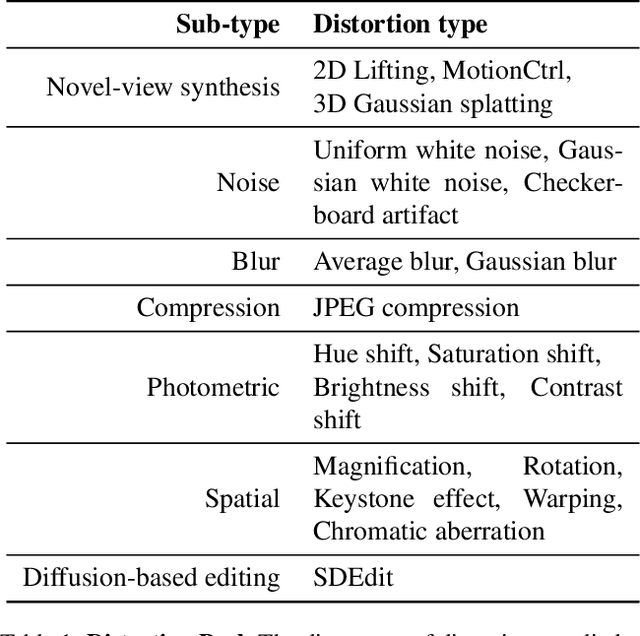
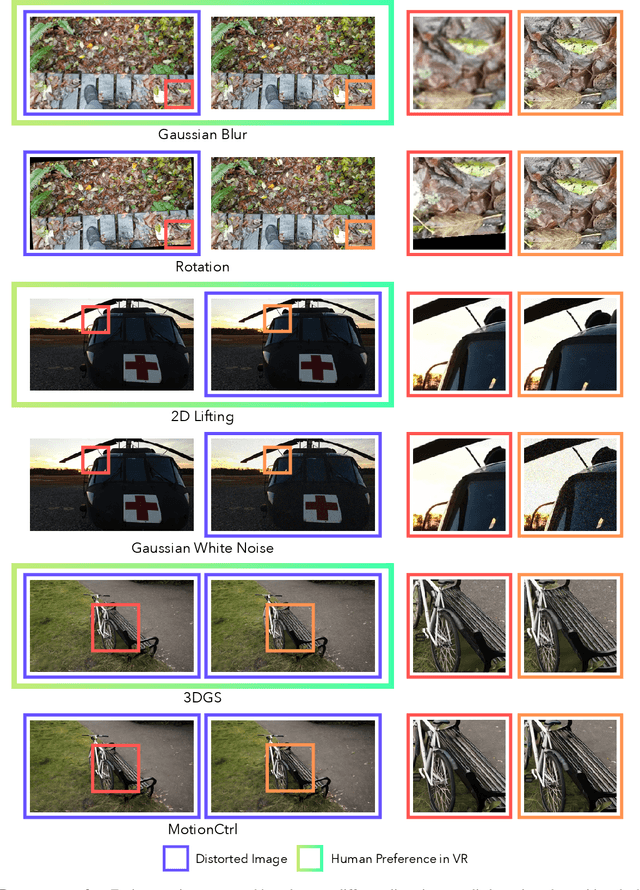
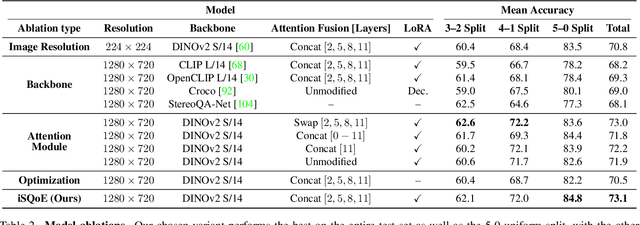
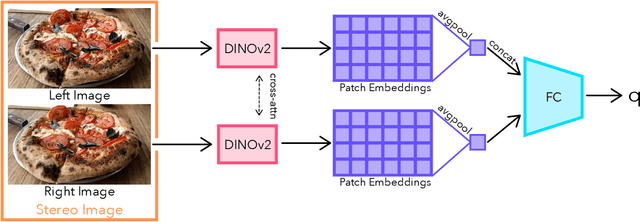
Abstract:With rapid advancements in virtual reality (VR) headsets, effectively measuring stereoscopic quality of experience (SQoE) has become essential for delivering immersive and comfortable 3D experiences. However, most existing stereo metrics focus on isolated aspects of the viewing experience such as visual discomfort or image quality, and have traditionally faced data limitations. To address these gaps, we present SCOPE (Stereoscopic COntent Preference Evaluation), a new dataset comprised of real and synthetic stereoscopic images featuring a wide range of common perceptual distortions and artifacts. The dataset is labeled with preference annotations collected on a VR headset, with our findings indicating a notable degree of consistency in user preferences across different headsets. Additionally, we present iSQoE, a new model for stereo quality of experience assessment trained on our dataset. We show that iSQoE aligns better with human preferences than existing methods when comparing mono-to-stereo conversion methods.
Automating the Search for Artificial Life with Foundation Models
Dec 23, 2024



Abstract:With the recent Nobel Prize awarded for radical advances in protein discovery, foundation models (FMs) for exploring large combinatorial spaces promise to revolutionize many scientific fields. Artificial Life (ALife) has not yet integrated FMs, thus presenting a major opportunity for the field to alleviate the historical burden of relying chiefly on manual design and trial-and-error to discover the configurations of lifelike simulations. This paper presents, for the first time, a successful realization of this opportunity using vision-language FMs. The proposed approach, called Automated Search for Artificial Life (ASAL), (1) finds simulations that produce target phenomena, (2) discovers simulations that generate temporally open-ended novelty, and (3) illuminates an entire space of interestingly diverse simulations. Because of the generality of FMs, ASAL works effectively across a diverse range of ALife substrates including Boids, Particle Life, Game of Life, Lenia, and Neural Cellular Automata. A major result highlighting the potential of this technique is the discovery of previously unseen Lenia and Boids lifeforms, as well as cellular automata that are open-ended like Conway's Game of Life. Additionally, the use of FMs allows for the quantification of previously qualitative phenomena in a human-aligned way. This new paradigm promises to accelerate ALife research beyond what is possible through human ingenuity alone.
Personalized Representation from Personalized Generation
Dec 20, 2024Abstract:Modern vision models excel at general purpose downstream tasks. It is unclear, however, how they may be used for personalized vision tasks, which are both fine-grained and data-scarce. Recent works have successfully applied synthetic data to general-purpose representation learning, while advances in T2I diffusion models have enabled the generation of personalized images from just a few real examples. Here, we explore a potential connection between these ideas, and formalize the challenge of using personalized synthetic data to learn personalized representations, which encode knowledge about an object of interest and may be flexibly applied to any downstream task relating to the target object. We introduce an evaluation suite for this challenge, including reformulations of two existing datasets and a novel dataset explicitly constructed for this purpose, and propose a contrastive learning approach that makes creative use of image generators. We show that our method improves personalized representation learning for diverse downstream tasks, from recognition to segmentation, and analyze characteristics of image generation approaches that are key to this gain.
Adaptive Length Image Tokenization via Recurrent Allocation
Nov 04, 2024



Abstract:Current vision systems typically assign fixed-length representations to images, regardless of the information content. This contrasts with human intelligence - and even large language models - which allocate varying representational capacities based on entropy, context and familiarity. Inspired by this, we propose an approach to learn variable-length token representations for 2D images. Our encoder-decoder architecture recursively processes 2D image tokens, distilling them into 1D latent tokens over multiple iterations of recurrent rollouts. Each iteration refines the 2D tokens, updates the existing 1D latent tokens, and adaptively increases representational capacity by adding new tokens. This enables compression of images into a variable number of tokens, ranging from 32 to 256. We validate our tokenizer using reconstruction loss and FID metrics, demonstrating that token count aligns with image entropy, familiarity and downstream task requirements. Recurrent token processing with increasing representational capacity in each iteration shows signs of token specialization, revealing potential for object / part discovery.
Learning Visual Parkour from Generated Images
Oct 31, 2024


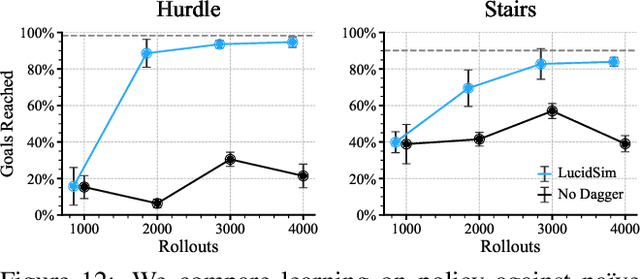
Abstract:Fast and accurate physics simulation is an essential component of robot learning, where robots can explore failure scenarios that are difficult to produce in the real world and learn from unlimited on-policy data. Yet, it remains challenging to incorporate RGB-color perception into the sim-to-real pipeline that matches the real world in its richness and realism. In this work, we train a robot dog in simulation for visual parkour. We propose a way to use generative models to synthesize diverse and physically accurate image sequences of the scene from the robot's ego-centric perspective. We present demonstrations of zero-shot transfer to the RGB-only observations of the real world on a robot equipped with a low-cost, off-the-shelf color camera. website visit https://lucidsim.github.io
When Does Perceptual Alignment Benefit Vision Representations?
Oct 14, 2024

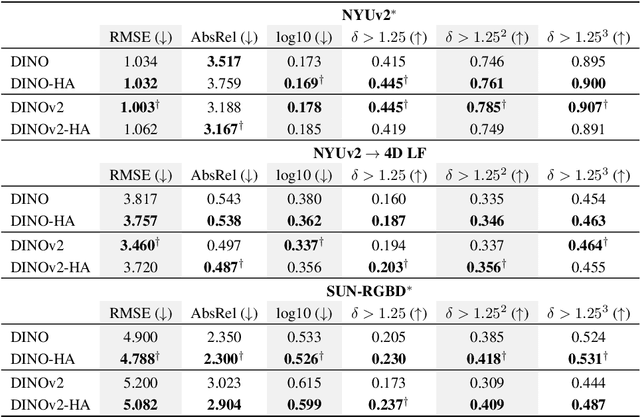
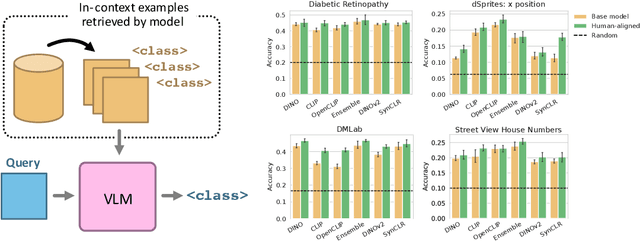
Abstract:Humans judge perceptual similarity according to diverse visual attributes, including scene layout, subject location, and camera pose. Existing vision models understand a wide range of semantic abstractions but improperly weigh these attributes and thus make inferences misaligned with human perception. While vision representations have previously benefited from alignment in contexts like image generation, the utility of perceptually aligned representations in more general-purpose settings remains unclear. Here, we investigate how aligning vision model representations to human perceptual judgments impacts their usability across diverse computer vision tasks. We finetune state-of-the-art models on human similarity judgments for image triplets and evaluate them across standard vision benchmarks. We find that aligning models to perceptual judgments yields representations that improve upon the original backbones across many downstream tasks, including counting, segmentation, depth estimation, instance retrieval, and retrieval-augmented generation. In addition, we find that performance is widely preserved on other tasks, including specialized out-of-distribution domains such as in medical imaging and 3D environment frames. Our results suggest that injecting an inductive bias about human perceptual knowledge into vision models can contribute to better representations.
Scalable Optimization in the Modular Norm
May 23, 2024



Abstract:To improve performance in contemporary deep learning, one is interested in scaling up the neural network in terms of both the number and the size of the layers. When ramping up the width of a single layer, graceful scaling of training has been linked to the need to normalize the weights and their updates in the "natural norm" particular to that layer. In this paper, we significantly generalize this idea by defining the modular norm, which is the natural norm on the full weight space of any neural network architecture. The modular norm is defined recursively in tandem with the network architecture itself. We show that the modular norm has several promising applications. On the practical side, the modular norm can be used to normalize the updates of any base optimizer so that the learning rate becomes transferable across width and depth. This means that the user does not need to compute optimizer-specific scale factors in order to scale training. On the theoretical side, we show that for any neural network built from "well-behaved" atomic modules, the gradient of the network is Lipschitz-continuous in the modular norm, with the Lipschitz constant admitting a simple recursive formula. This characterization opens the door to porting standard ideas in optimization theory over to deep learning. We have created a Python package called Modula that automatically normalizes weight updates in the modular norm of the architecture. The package is available via "pip install modula" with source code at https://github.com/jxbz/modula.
 Add to Chrome
Add to Chrome Add to Firefox
Add to Firefox Add to Edge
Add to Edge